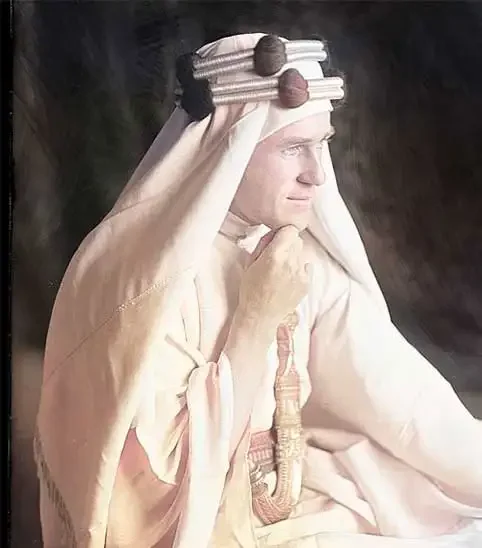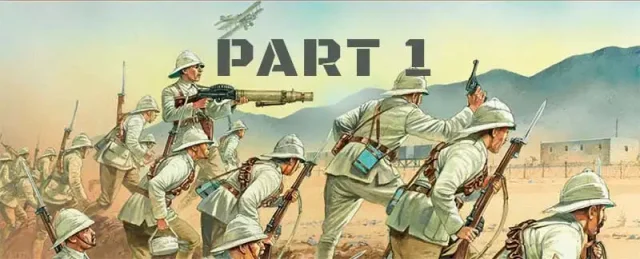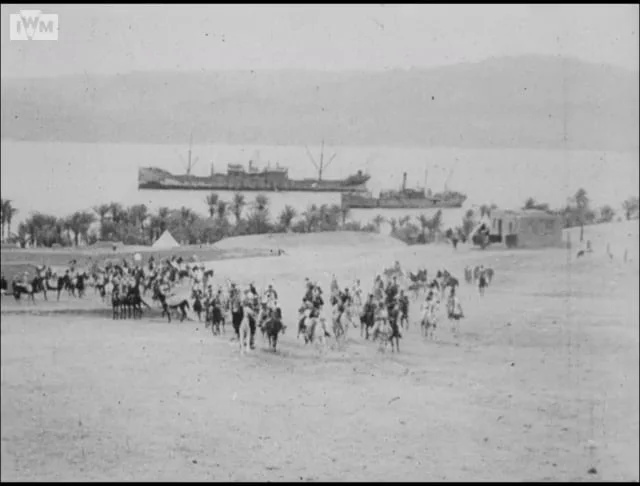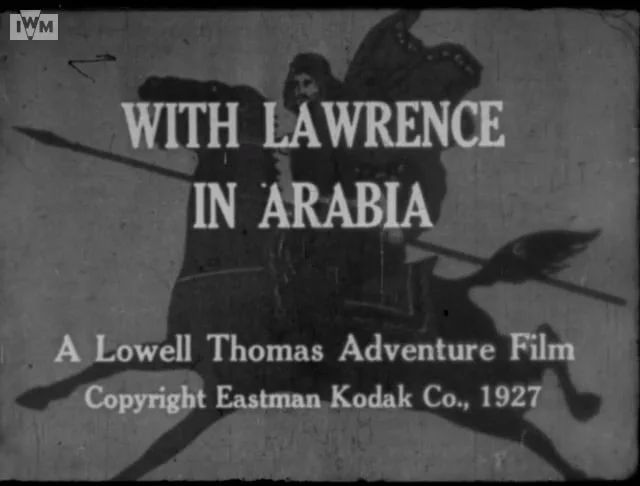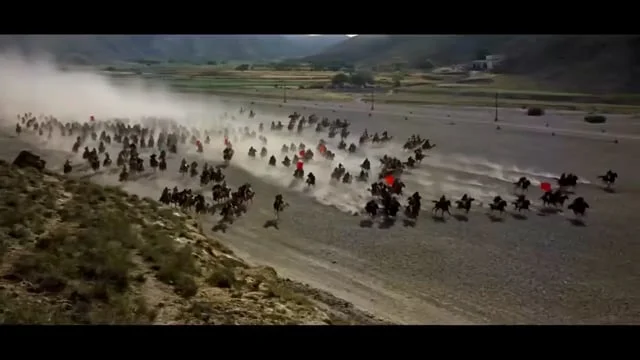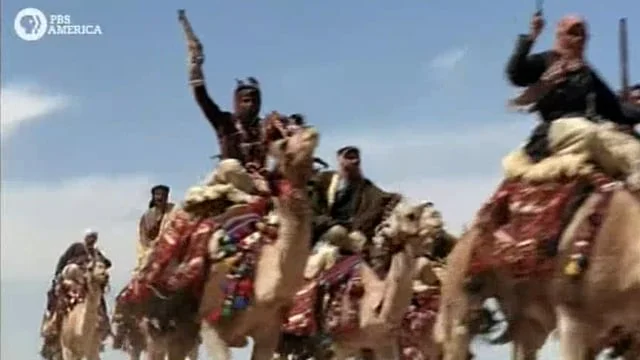- Military History
- Biographies
- Militarians Biographies
- Thomas Edward Lawrence (Lawrence of Arabia)
Thomas Edward Lawrence (Lawrence of Arabia)
Mankind has had ten-thousand years of experience at fighting and if we must fight, we have no excuse for not fighting well - T.E. Lawrence
One of the 20th century's most iconic characters was Thomas Edward Lawrence (1888–1935), known as "Lawrence of Arabia". Though not a career soldier, his World War I achievements changed the outcome. In fact, this amateur soldier helped create the contemporary Middle East.
Nothing in his early life suggested he would achieve military success. At the start of the war, Lawrence ('Ned' to family and friends) seemed set for an archeological career. He also expressed a wish to write or publish to friends. Lawrence served quietly until 1916 after volunteering in 1914. Lawrence's military action intensified after the Arab Revolt that year. He would become famous for his wartime heroics. By the end of the war, he was a full colonel and had received numerous decorations. Most of his peers believed he would have a significant military or political career. Lawrence chose anonymity, fueling popular intrigue and cementing his image as one of the most intriguing figures of his time.
Index of Content T.E. Lawrence Biography
Lawrence was remarkable and lived through unusual times. He was skilled at assessing Arab elites and persuading them to embrace the Allied uprising vision after arriving in Arabia in 1916. Lawrence succeeded in guerrilla warfare almost naturally. Despite his lack of military expertise, he properly assessed his enemy's weaknesses and created the finest attack methods. Lawrence escaped the attritional fighting on the Western Front, but two of his brothers died there. He emerged from the war profoundly mentally damaged. Post-war peace conference failures increased his personal troubles, since he wanted more Arab independence. By 1922, he was virtually invisible. He later worked on RAF high-speed rescue craft to avoid attention. Lawrence loved speed and had supercharged Brough motorbikes in the 1920s and 1930s. He died in 1935 after a few months of retirement from the RAF.
Few World War I commanders have generated such historical interest. Almost every year, a new biography of this odd scholar-soldier is published. Because so much has been written about Lawrence, it's hard to get a true sense of him, made much harder by his complicated personality. He was an outstanding guerrilla warfare leader and unconventional military commander. Lawrence's career was in the spotlight again as coalition forces battled the insurgencies in Iraq and Afghanistan. Although Lawrence fought in a different world, his military and political insights are still useful today. A new generation of professional soldiers is researching this amateur soldier's writings and career.
The Legacy of Lawrence of Arabia - Documentary from BBC Scotland (more videos at the end of this biography)
The Early Years of T.E. Lawrence
Thomas Edward Lawrence was born on August 16, 1888, in Tremadog, North Wales. He was born into an unconventional family in the late Victorian era. His father was Sir Thomas Robert Tighe Chapman of South Hill, Delvin, Westmeath, Ireland. This Anglo-Irish gentleman came from a famous Elizabethan planter family in Ireland. Sarah Lawrence, a Scottish governess, became Sir Thomas Chapman's nanny and governess to his four daughters in 1879. Chapman left his wife, children, and ancestral house to run away with Sarah Lawrence, although when they started dating is unknown. They had five sons: Montagu Robert (1885), Thomas Edward (1888), William George (1889), Frank (1893), and Arnold Walter (1900). Chapman and Sarah never married because he was never divorced.
The pair resided as "Mr. and Mrs. Lawrence" in several locations before moving to Oxford in 1896 and purchasing a property on Polstead Road. Lawrence would later humorously declare that he was aware of his parents' predicament, and thus his own illegitimacy, from childhood. It is unclear when he discovered this, but it appears to have bothered him. Lawrence's early Oxford years weren't all bad. He attended the City of Oxford High School from 1896 to 1907. Though he was not bright, he was a smart student. He preferred solitary activities like canoeing and cycling to team sports, unlike his peers. Being only 168cm tall (5'6"), he was never outstanding. He did, however, have significant strength and endurance, which would serve him well during his wartime career.
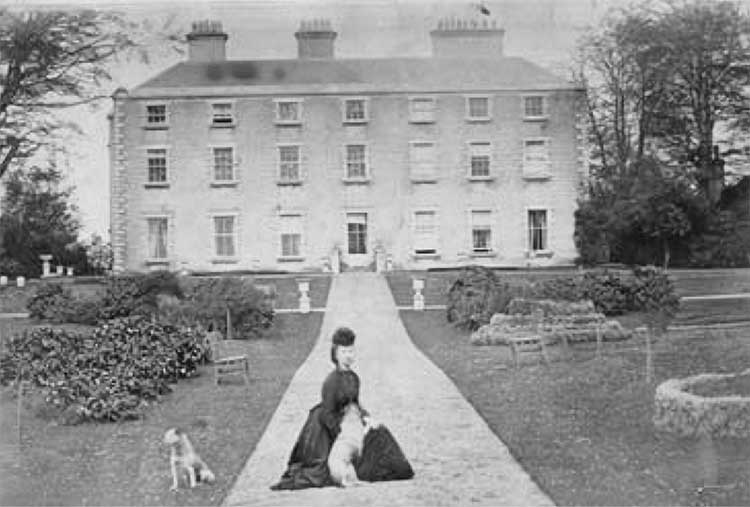
He never considered military service as a child. He appeared destined for academics because of his interest in archaeology and history. He visited local historical places and, during a reconstruction program in Oxford, collected items of interest from workers, which he later handed to the Ashmolean Museum, launching a long relationship with that institution. He told relatives and friends he wanted to work in fine printing. He was an adventurous traveler who studied castles in France in 1906 and 1907. Early travels were with his father, but subsequently he traveled alone. It is also thought that around 1905-06, he fled his house after a disagreement and joined the Royal Garrison Artillery in Cornwall. It appears his father bought him out of this enlistment.
In 1907, he enrolled at Jesus College, University of Oxford, where he pursued his studies in medieval castles. In summer 1908, he returned to France, and in summer 1909, he visited Syria to see crusader castles. He walked 1,770km (1,100 miles) through Syria and Palestine with a backpack and camera, a risky undertaking at the time. It was claimed in Aleppo publications that he was shot and killed. These study visits fueled his Bachelor of Arts thesis, The Crusades' Impact on European Military Architecture. His thesis effectively demonstrated that eastern advances had affected European castle architecture, not vice versa. This research earned him a first-class honors degree in 1910. After returning to the Middle East, he studied Arabic in Jebail, Lebanon. He was also eccentric at university, and when he joined the Officer Training Corps, he impressed classmates as an exceptional rifleman and scout.
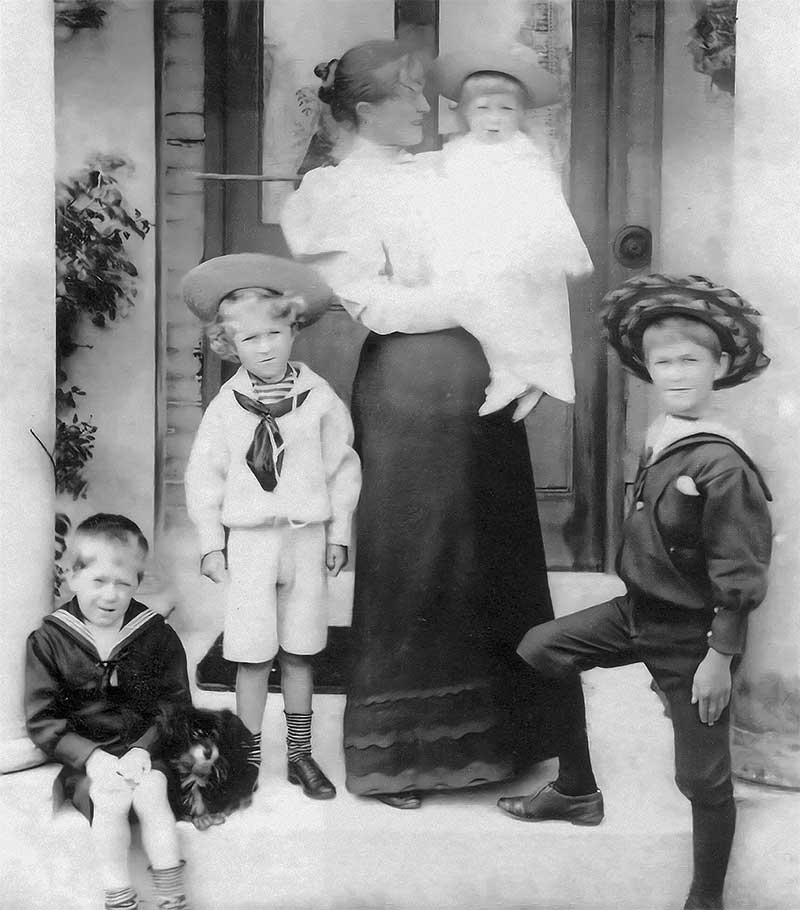
He began working for the British Museum in November 1910, assisting D. G. Hogarth of the Ashmolean Museum on the Carchemish archaeological dig in Syria. His interest in the Middle East was continuously growing. After arriving in Syria in early 1911, he spent the next four years in the Middle East, mostly doing archeological work. He worked in the Ottoman Empire, which would enter war with Britain in 1914. He gained valuable practical expertise for his wartime career. He learned Arabic and advanced his archeological work at Carchemish. As Carchemish excavation supervisor, he acquired great insight into Arab workers' customs. All of this helped him later. Lawrence explored northern Mesopotamia (Iraq) from Carchemish in 1911. It is likely that he spied on the German-built Berlin-Baghdad Railway at Carchemish. It is impossible to establish, but Lawrence gained extensive experience in a region he would later revisit in conflict. In March 1912, Lawrence returned to Carchemish after a brief apprenticeship with Flinders Petrie. Lawrence and Leonard Woolley were invited to explore the Sinai Peninsula in January 1914, introducing them to military intelligence. The Palestine Exploration Fund organized this non-military survey. The director of military operations in London commissioned this study to examine the challenges a British force would face in the event that the Ottoman Army launched an attack across the Sinai to Suez. Captain Stewart Newcombe, who would subsequently serve with Lawrence in Arabia, headed the expedition while Lawrence and Woolley provided civilian 'cover'.
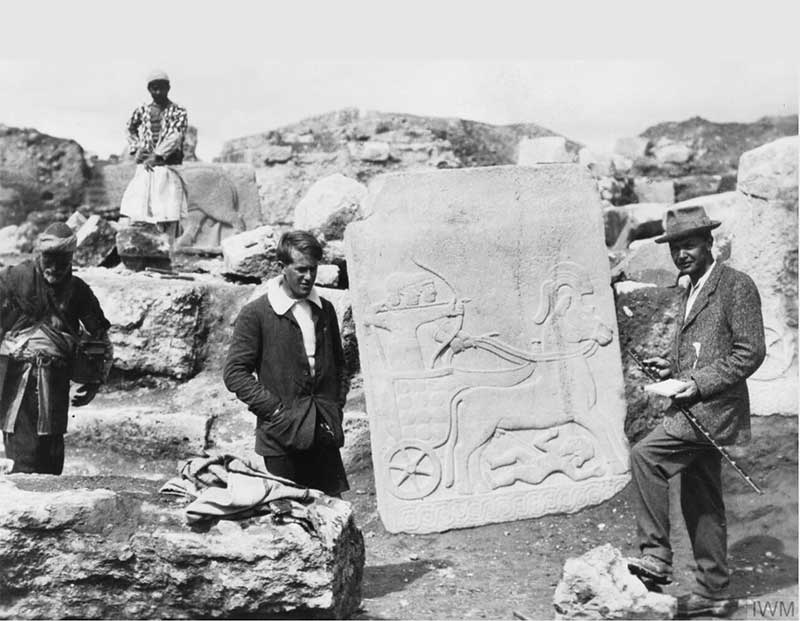
Although Lawrence loved amateur cloak-and-dagger since he got to tour Petra, he also learned military planning and surveying. After Lawrence volunteered for service in 1914, Cairo intelligence officers used his abilities and knowledge. As threats of war gathered, Lawrence ended the Carchemish dig and returned to England. He wrote The Wilderness of Zin (1914) from the Sinai expedition's archeological finds alongside Woolley. When war broke out, he joined the Geographical Section of the General Staff (Intelligence) in London's War Office. This was initially in a civilian capacity, but on October 26, he was conscripted into the army as a second lieutenant on the "Special List", a category intended for officers without a regimental affiliation and consequently assigned to special responsibilities. A few days later, the Ottoman Empire joined Germany and Austro-Hungary. In December 1914, Lawrence joined the Intelligence Department in Cairo. He was an archeologist in a wartime region. His understanding of these territories' languages, tribes, and topography was expected to help Lawrence fight the Ottoman Empire. Neither Lawrence nor anyone else could have predicted his importance in the following campaigns.
The Military Life of T.E. Lawrence
Lawrence would have admitted to being a military novice. He had served with the Officer Training Corps as an undergraduate, but he never considered the military. As a young man with a temporary commission, he joined GHQ's intelligence staff in Cairo in December 1914. The next two years were filled with excitement and routine, but he learned a lot about intelligence work and became a natural. When Lawrence arrived in Cairo, GHQ was expanding its intelligence section. Savoy Hotel rooms were taken to accommodate staff growth. Before the war, GHQ had a small intelligence staff; by 1918, it had over 700. Lawrence served under Colonel Gilbert 'Bertie' Clayton, whose second-in-command was Major (later Colonel) Stewart Newcombe, with whom Lawrence had explored the Sinai in 1914. Throughout the war, the section reported intelligence to various commanders. Lawrence worked closely with Generals Sir John Maxwell (1914–15), Sir Archibald Murray (1915–17), and Sir Edmund Allenby (1917–18). The Sudan governor-general, Sir Reginald Wingate, oversaw the intelligence staff. London's War Office director of military intelligence, Lieutenant-General Sir George Macdonagh, received Cairo's intelligence reports.
Egyptian intelligence had many unusual personalities, many of whom were newly commissioned, like Lawrence. In this new military world, Lawrence looked messy. He didn't attend the military presentation, and officers often remarked on his uniform and untidiness. Lawrence was an eccentric but useful officer in this overcrowded intelligence environment. Lawrence had many responsibilities over the next two years. He was responsible for writing Ottoman territory reports and profiling military and political leaders. Some found the Lawrentian style of writing very irritating. However, his profiles of senior Ottoman figures were detailed and insightful into human nature. They spread to Cairo and London. He was ideal for interviewing prisoners due to his language and tribal knowledge. After the failed Ottoman attack on the Suez Canal, Turkish POWs increased, keeping Lawrence busy. He used a friendly, ingratiating style and found that Arab tribesmen who had been enlisted would talk freely after he showed his knowledge of Ottoman territories in Palestine and Syria. These interrogations gave him a picture of Ottoman Army morale and conditions. Lawrence and his fellow officers were not directly involved in counter-intelligence, but they became aware of Turko-German attempts to provoke Egypt, Britain's somewhat unwilling "protectorate".
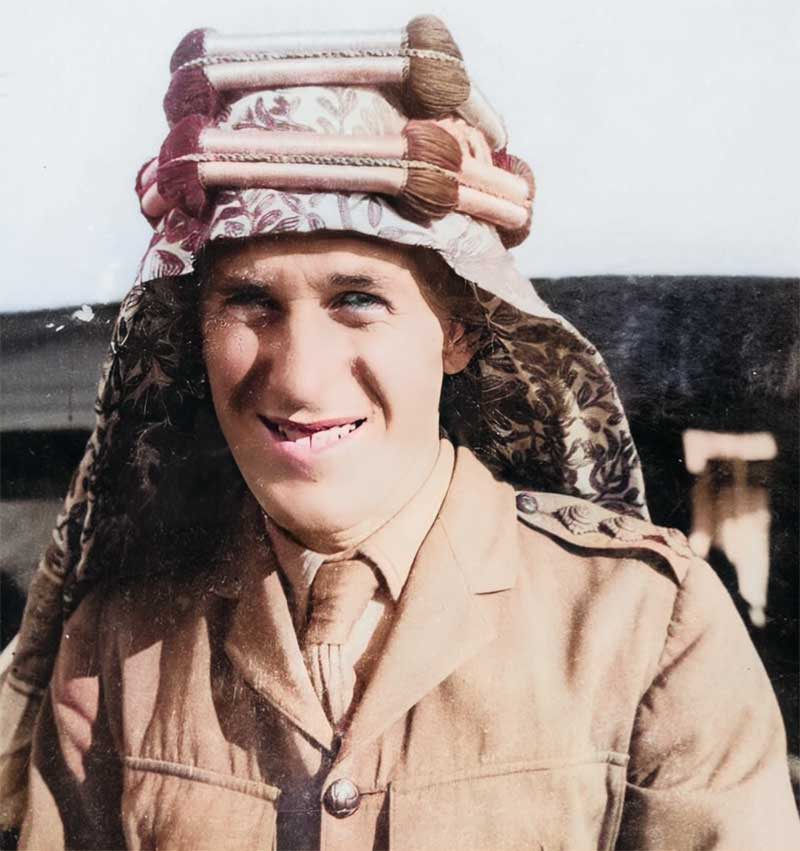
Lawrence saw the Gallipoli expedition preparations early in 1915. He described the expedition as "beastly ill-prepared, with no knowledge of where it was going, what it would meet, or what it was going to do". Lawrence was one of many officers who searched Cairo bookshops for expedition maps and assessed Turkish forces on Gallipoli. Several other officers volunteered for the expedition's intelligence staff. Lack of field experience prevented Lawrence from going. He also planned an expedition to Alexandretta (now Iskenderun) on the Syrian coast. This plan was promising and could have outflanked Turkish forces in Syria by landing an army behind them. Lawrence regretted that this plan was abandoned in favor of the disastrous Gallipoli operation. Lawrence's most important mission during this time was to Mesopotamia in March 1916 for GHQ and the newly established Arab Bureau. His first stop was to meet Ottoman Army defectors, Major Aziz Ali al-Mazri and Captain Muhammad al-Faruqi. He would evaluate their claims of Arab troop discontent and their suitability for leading a rebellion. Lawrence was then to explain the Arab Bureau's policies and functions to Colonel Percy Cox, the Indian Army's chief political officer in Mesopotamia. Thirdly, he was to meet with this force's intelligence officers to find ways to cooperate if Arabs revolted.
This mission led to tense meetings with Indian Army officers who resented him and the Arab Bureau's goals. Lawrence had difficult conversations with al-Mazri and al-Faruqi. Both informed Lawrence of al-Ahd, an underground movement. They claimed Arab forces were ready to rebel and desired British support and independence if they did. It appeared that their claims were exaggerated, and Lawrence was disappointed to learn that they were open to German support! Events at Kut overshadowed Lawrence's political indecision. Khalil Pasha, the local Ottoman commander, offered General Townshend terms for surrender. Townshend offered cash if his army left Kut. Political pressure mounted to see if al-Mazri and al-Faruqi could stage their promised rebellion, which General Lake disliked. He probably also correctly concluded that the plan was too ambitious.
The situation got stranger in the weeks that followed. A £1 million gold offer was made to release Townshend's army at Kut. Cemal Pasha, the Ottoman governor of Syria and commander of the 4th Field Army, asked in a secret communication if he would be recognized as Syria's independent ruler. Lawrence left Basra on April 9, 1916, for the front after meeting with Cox and Iraqi expert Gertrude Bell. He witnessed one of the war's most surreal events there. Lawrence rode a gunboat upriver to General Lake's headquarters on April 19. Lake considered encouraging the rebellion unacceptable, so he was met with hostility. Lawrence interrogated Arab POWs, but when another relieving force was defeated, the plan to buy the besieged army's release was taken seriously into consideration. Townshend offered £1 million again in the morning of April 27 if Khalil Pasha let his men and artillery leave Kut. Khalil declined the offer after some thought.
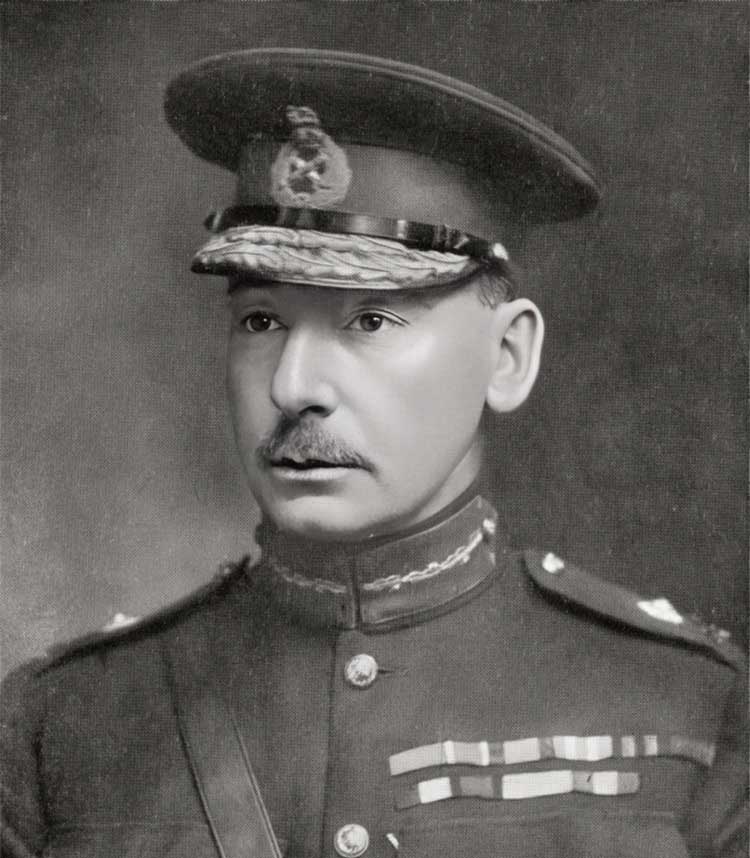
Lawrence, Herbert, and Beach were ordered to cross Turkish lines and begin negotiations on April 28. They could exchange Arab POWs for Kut's sick and wounded. Lawrence and his fellow officers were brought before Khalil Pasha under a truce flag and had more unsuccessful talks. Lawrence used this opportunity to evaluate Khalil and noted that the Ottoman commander was suspicious of Arab troops and would not exchange them. Lawrence believed this was because of Arab regiment discontent. They returned to British lines in the morning of April 30. Their Turkish hosts had prepared a lavish dinner for them, but their mission failed. Lawrence returned to Cairo, depressed. He was unhappy with the entire expedition. The Indian Army officers' campaign horrified him. The uncertain nature of their potential Arab allies also unnerved him. Because of his harsh criticism, his mission report had to be softened down before publication. Lawrence would play the role he had always wanted when events took a critical turn that could change the Middle East campaign.
The Hour of Destiny for T.E. Lawrence
Military subordinate Lawrence was frustrated with his routine and his insubordination to his superiors. Lawrence became restless and critical of Major G. V. W. Holdich as he wanted to go to the Hejaz, where the Arab Revolt had started in June 1916. The Hejaz revolt had spread by the time Lawrence arrived after several months. Sharif Hussein of Mecca realized the Ottomans were coming for him in early 1916. An alternative Sharif of Mecca, like Sharif Ali Haidar, was rumored. The Ottomans tried to control the importation of weapons and military equipment into the Hejaz, and Syrian nationalists informed Hussein that Damascus was forming an expeditionary force to attack Mecca. Sharif Hussein's sons were in charge of the initial Arab Army, which had an estimated 30,000 tribesmen. These tribesmen were from western Arabian Peninsula tribes. Emirs Ali and Feisal informed General Fakhri Pasha, Ottoman commander at Medina, of Arab plans to leave the Ottoman Empire on June 5, 1916. The Hejaz Railway was attacked after their town attack failed. Five days later, their father declared the revolt in Mecca and attacked the garrisons there and Ta'if.
At this crucial point, the revolt needed outside help to continue. British officers, Egyptian Army troops, mountain guns, and machine guns landed in Jiddah on June 30 after capturing the port town on June 16. The Arab Revolt's breakout from the coastal area under its direct control was uncertain as the garrisons at Mecca and Ta'if held out. The last Mecca garrison surrendered on July 9 with Egyptian Army artillery support, while the Ta'if garrison held out until September 22. In the early weeks of 1916, British officer Lawrence was in Cairo, reporting and predicting Hejaz events. He designed new stamps for the Hashemite Hejaz in collaboration with the Arab Bureau. Getting into the field was his main goal. As events unfolded in Arabia, the revolt's future was uncertain. General Murray was urged to send a brigade to support the Arab forces, but he wanted to keep as many troops in Egypt as possible and was concerned about sending European troops to a Muslim holy land.
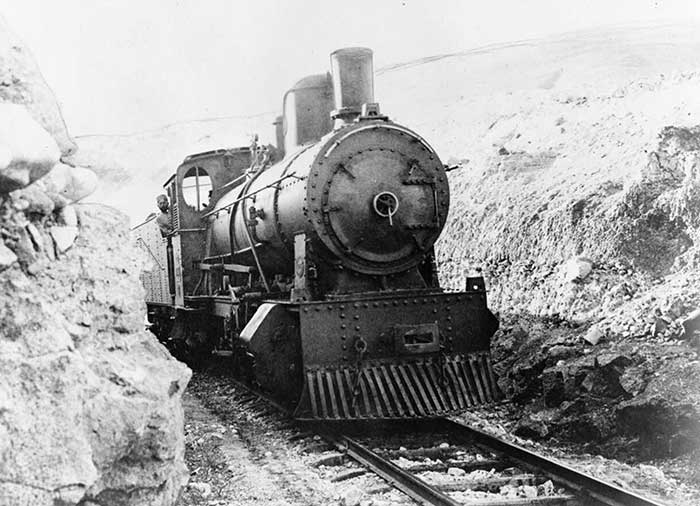
Senior Cairo officers and Arab Bureau officials debated how to nurture the revolt in September and October and whether it was possible. Many of these discussions were pessimistic about the Arab cause. September 1916 saw the French 'Military Mission to Egypt' arrive, clearly an Allied mission. Colonel Edouard Brémond led the 1,100-man French force at Port Said. Lawrence tried to stop French plans for Arabia throughout the campaign. Ottoman forces planned a major offensive to quell the uprising. Ottoman counterattacks relied on General Fakhri Pasha, who had strengthened his army at Medina and received two new aircraft. In autumn 1916, it appeared the revolt would be put down before Christmas, giving Lawrence his chance. In early October 1916, Colonel Clayton of Military Intelligence suggested Lawrence go to Arabia to assess the military situation and report back. The two-day voyage discussed the revolt's political and military future, with al-Mazri proposing a military plan similar to Lawrence's.
For more details about his involvement in the World War I and especially in Arabia during de Arab Revolt you should read our five parts series:
Rabegh to Wejh, October 1916 to January 1917
Lawrence's initial role in the Arab War was largely political, as military officers with the Arab Army were already working in coastal towns and training Arab tribesmen. Captain Boyle was in charge of the Royal Navy's Red Sea Patrol, and Captain A. J. Ross was in charge of a small Royal Flying Corps contingent. Lawrence's opinionated style caused antagonization among these officers, leading to Colonel Wilson accusing him of being the only authority on war, engineering, and HM's ships.
However, Lawrence's unique skills came in dealing with Arab leaders, such as Hussein's elder sons Ali and Abdullah, who intended to keep their forces near Mecca and Medina for long-term strategic goals. In late 1916, Lawrence began to focus on Feisal, who was encamped near Yanbu with around 8,000 tribesmen and 1,500 Egyptian troops and irregulars. He discovered Feisal to be hostile and depressed due to recent military setbacks and the British government's slow supply of weapons. Feisal's main concern was the Turkish forces at Medina under Fakhri Pasha. In the final months of 1916, it was clear that forces were being massed in preparation for a countermove against the Arabs. Lawrence promised Feisal further support and became embroiled in the debate on whether a full British brigade should be sent to bolster the Arab forces. He correctly assessed that the majority of the Arab forces had the mindset, training, and weapons to mount a successful long-term defense of Rabegh and Yanbu.
Lawrence returned to his proper place at GHQ in Cairo, initially resisting being told to act as a liaison officer to Feisal. In December 1917, British officer Lawrence Lawrence arrived in the midst of the Arab Revolt, which had reached its worst crisis. Fakhri Pasha had left Medina with two brigades to reclaim Yanbu and Rabegh, but Turkish forces had outflanked an Arab position in Wadi Safra and Hamra, leaving the Ottoman commander in control of the routes to both cities. Lawrence found Feisal at Nakhl Mubarak with around 4,000 tribesmen, and despite the desperate situation, he found Feisal calm and dignified.
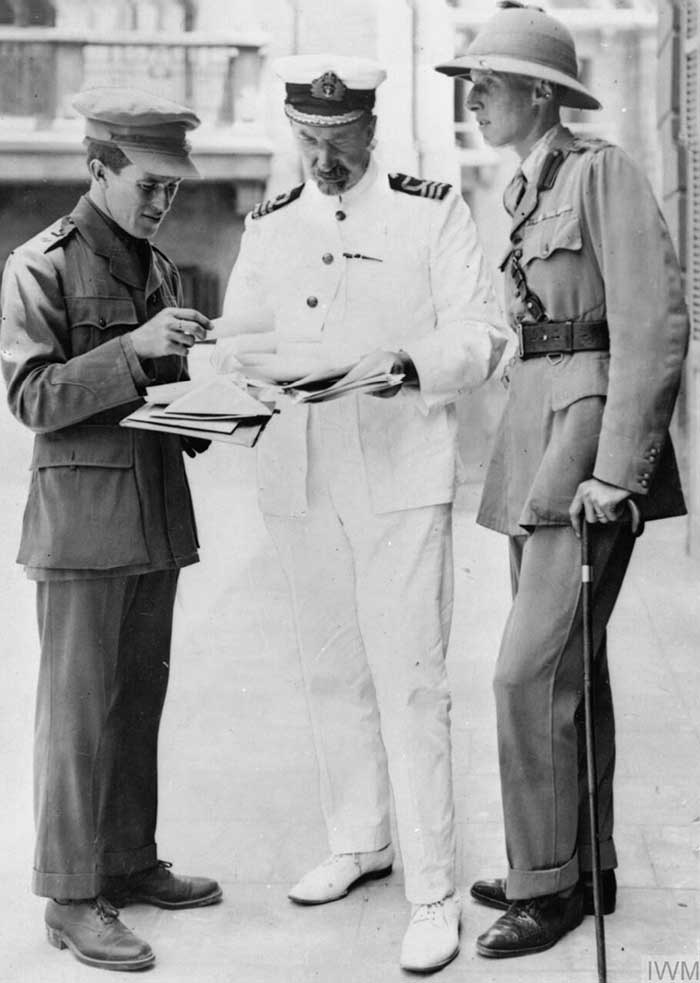
The fortunes of the Arab Revolt hung in the balance as Turkish forces moved towards Yanbu, pushing aside the Arab forces sent to oppose them. Lawrence laid out a forward airfield for use by the RFC flight based at Yanbu and later claimed that Feisal invited him to wear Arab dress and presented him with a set of robes that he had sent from Mecca. After further meetings with the Arab leaders, Lawrence hastened back to Yanbu, where he found Lt. Garland busy preparing the defense of the town with a force of around 1,500 men. Lawrence sent an urgent message to Captain Boyle of the Royal Navy's Red Sea Patrol, who ultimately turned the balance in the Arabs' favor. Five ships of the Red Sea Patrol arrived off the coast at Yanbu. The small flotilla also included the Raven, a seaplane carrier, and in the days that followed, Royal Navy seaplanes attacked the Turkish columns as they advanced on the town.
The turning point came during the night of December 11–12, when the Turks had advanced right to Yanbu, but they called off their attack because Fakhri Pasha realized that Royal Navy guns and searchlights covered the town. Despite logistical problems, RFC attacks on Medina, sickness in his army, and attacks along his lines of communication, the Ottoman commander called off his offensive, almost seeing the Arab Revolt snuffed out while still in its infancy.
1917 Railway Campaign
The Arab Revolt in early 1917 was a significant turning point in the conflict, as the Arabs took control of the situation following the challenges of late 1916. This indicated the ongoing rebellion and backing from both the British and the French. Lawrence joined Feisal's army, and leaders from different tribes, including those from Ottoman Syria, swore loyalty to Feisal and the Hashemite movement. At times, tribal hostilities would intensify and lead to rebellion, requiring Feisal to step in.
Relocating to Wejh was strategically important because it enabled a significant assault on the Hejaz Railway. Lawrence and Feisal's original plan was to launch an attack on the railway to disrupt the flow of supplies and reinforcements to Medina, with the goal of pressuring the Turkish garrison into surrendering. General Murray led a new offensive in March 1917 with the goal of capturing Fakhri Pasha in Medina. Under the direction of Lieutenant-Colonel Stewart Newcombe, Lt. Henry Garland, and Lieutenant Hornby in early 1917, small groups traveled from Wejh in the direction of the railway with Arab officers like Major al-Mazri. Due to Lawrence's limited field experience, he became the highest-ranking British officer in charge at Wejh.
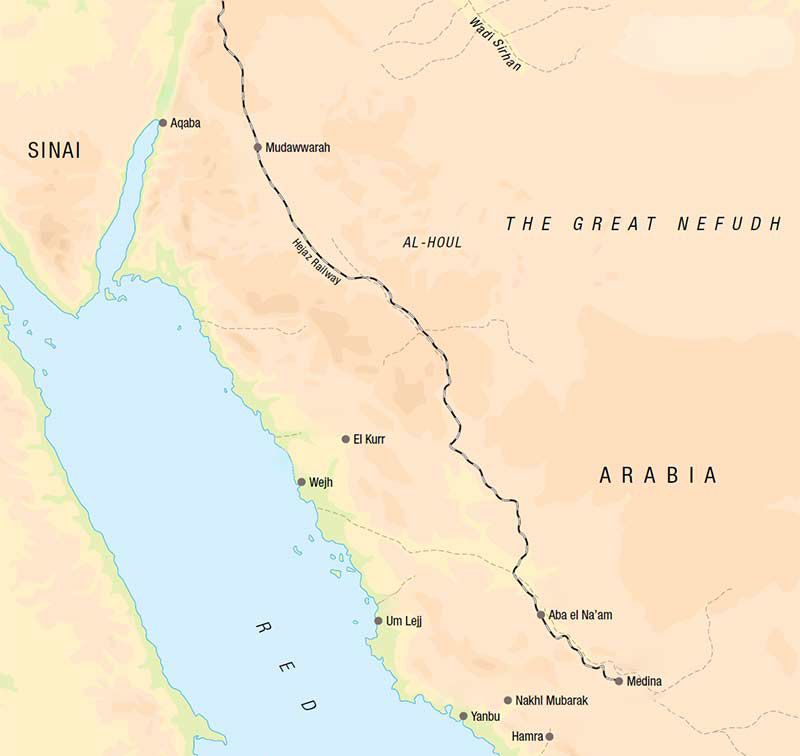
In March 1917, Lawrence traveled to Wadi 'Ais to advise Emir Abdullah to launch an attack on the railway. He and his group assaulted the railway between Aba al-Na'am and Istabl Antar by sabotaging the tracks, planting explosives, and causing a train to partially derail. Despite Turkish gunfire repelling Lawrence, his initial raid was successful, and he gained useful knowledge for subsequent missions. During the campaign, Lawrence and other officers conducted multiple raids on the Hejaz Railway, with raiding parties growing in size and occasionally reaching up to 200 men. They employed different techniques to inflict extensive destruction, like deforming rails with 'tulip mines', forcing Turkish repair teams to disassemble damaged portions before installing new ones. Lawrence chose to target curved sections of the railway line because it was harder to find and install new rails for these areas.
Lawrence and his raiding parties focused on secondary infrastructure such as the telegraph line, station buildings, water towers, Turkish blockhouses, and bridges. The bridges were demolished, leaving the damaged central section intact, necessitating a hazardous demolition process before reconstruction. The attacks disrupted the supply flow to Medina and hindered evacuation efforts. During the war, the Turkish Army focused on safeguarding the railway and deploying mobile units to counter raiding parties. The efficacy of the railway campaign's impact is still a topic of debate. Fakhri Pasha asserted that the Medina garrison was never close to starvation because they received supplies from the pro-Ottoman Shammar tribe. Fakhri Pasha retained an army of more than 10,000 soldiers despite the destruction of the railways, and the Medina garrison held out until January 1919.
Aqaba, May-July 1917
Lawrence's significant expedition to Aqaba in 1917 was a notable achievement in his career in Arabia. He guided a small band of tribesmen through hostile territory to execute a surprise attack on a town of strategic significance. By May 1917, Arab forces had divided into three armies: the Arab Northern Army under Feisal, the Arab Southern Army under Emir Ali, and the Arab Eastern Army under Emir Abdullah. The armies would stay in these locations to oppose Ottoman forces and Shammar tribesmen. Although the campaign against the Hejaz Railway was successful, Lawrence and Feisal looked for ways to continue the war effort. Syrian tribesmen like Auda abu Tayi, Nasib al-Bakri, and Zaki Drubi encouraged Feisal to extend the revolt to their territories and pledged their assistance. Feisal identified the fertile areas of Palestine and Syria as essential for the sustenance of a prospective Hashemite state in the Hejaz. In May 1916, Britain, France, and Russia approved the Sykes-Picot Agreement, which divided Ottoman territory in Arabia and the Levant among the Allied countries. By establishing a new Arab state under Feisal's leadership, Lawrence hoped to thwart French ambitions in Syria. Lawrence was under strain due to this deception, which eventually led to a letter proposing suicide.
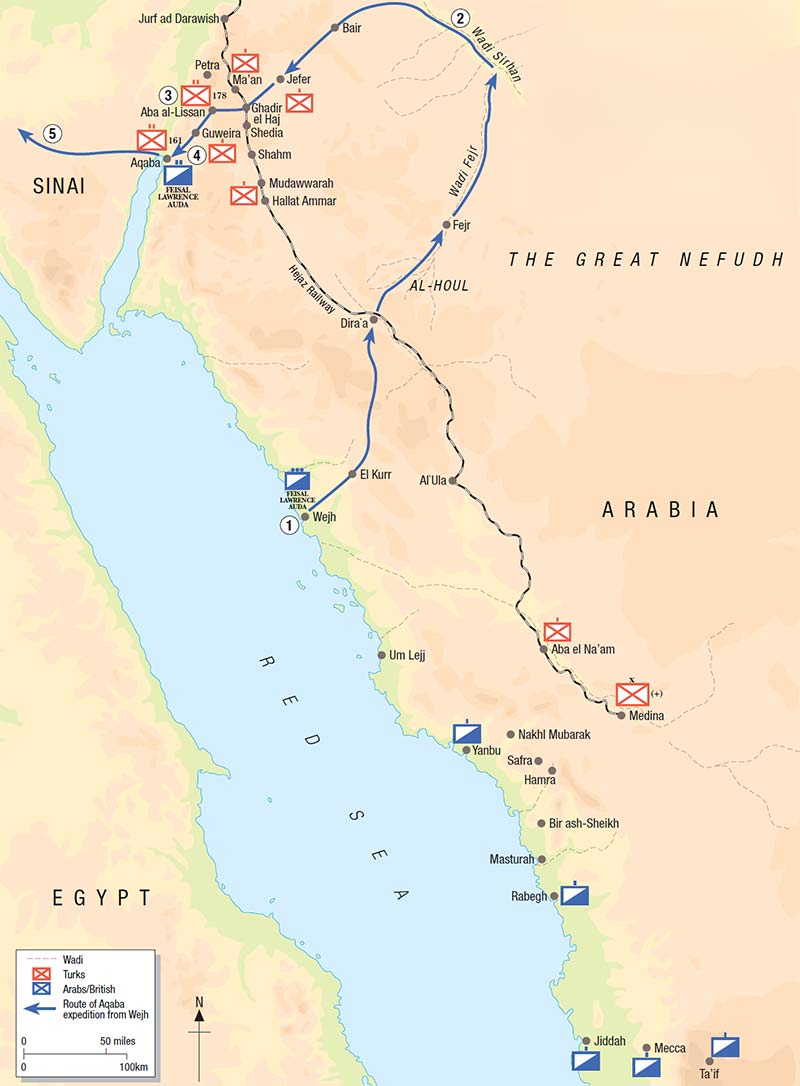
During political unrest, Lawrence concentrated on seizing Aqaba, the final Red Sea port under Ottoman control. He thought that capturing it could be used as a strategic point for Feisal's army to move forward into Palestine, Lebanon, and Syria. Seizing Medina would isolate the city and make it vulnerable to more attacks on the northern parts of the Hejaz Railway. Having an Arab Army stationed there would disrupt Ottoman forces in Sinai and Palestine as they prepared themselves to counter additional British attacks. Lawrence first described the strategy as a long-term attack that would target Ma'an and coincide with a significant raid that Newcombe would lead toward al 'Ula. He departed from Wejh with a small group and 17 Agayl tribesmen to reach out to the Howeitat near Aqaba and recruit them for the assault. The plan included traversing more than 1,000 kilometers (620 miles) of desert, which included the notorious section referred to as 'al-Houl' or 'the Terror'.
Lawrence undertook a perilous journey to locate his servant, Gasim, who had tumbled from his camel. Lawrence successfully rescued Gasim despite facing resistance from his fellow travelers. He proceeded north to rendezvous with Syrian officials, ultimately arriving on the outskirts of Damascus. He conducted a diversionary attack during the expedition, destroying a bridge near Ras Baalbek. This action resulted in six Ottoman battalions being redirected to address the potential general uprising. Lawrence conducted reconnaissance to assist GHQ in planning additional operations in Palestine and Syria. Upon returning to Wadi Sirhan, he discovered that Arab leaders had recruited 500 men of the Howeitat, 150 men of the Rwalla and the Shararat, and 35 tribesmen from the Kawikiba. With this force, Lawrence began his last approach towards Aqaba. The main Ottoman defenses in the town were designed to defend against sea attacks, but there were also Ottoman troops between Lawrence's force and Aqaba. The Turks had destroyed wells to the north-east of the town, suggesting they were alert to potential attacks from the desert. Diversionary attacks were carried out against the railway, and a party of the Howeitat took the Ottoman fort at Fuweilah, killing almost the entire garrison in reprisal for Turkish treatment of the local population.
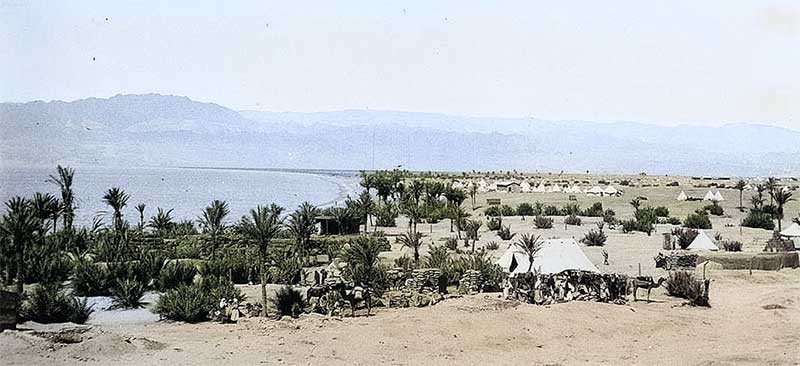
Lawrence and his Arab forces faced a dilemma as the main contingent of the Turkish battalion was encamped at Aba al-Lissan, preventing their advance on Aqaba. On July 2, Lawrence and the Arab leaders attacked the Turkish battalion, but the attack stalled due to the tribesmen seeking shelter. Lawrence had to decide whether to retreat back to Wejh or face Turkish reinforcements. In a carefully worded exchange with Auda abu Tayi, Auda led a charge of around 50 horsemen into the Turkish battalion, resulting in around 300 fatalities and 160 prisoners. Turkish garrisons were overrun, including those at Guweira, Kathira, and Hadra. One captured Turkish officer was persuaded to send letters to the garrison in Aqaba, offering them assurances of proper treatment if they surrendered. Lawrence and his companions found further posts abandoned as they made their final march on the town.
On July 5, there was a short exchange of fire at Khadra, and Lawrence found his force had swelled to over 1,000 men as tribesmen of the Howeitat and Haywat arrived to participate in the final attack. Despite attempts at negotiations to induce surrender, the Turkish commander at Aqaba decided to capitulate after an exchange of fire on July 6. The Arabs' final dash took place without a shot being fired, and Lawrence later summarized the final act in his memoir, Seven Pillars of Wisdom. Lawrence and his Arab forces faced a dilemma as the main contingent of the Turkish battalion was encamped at Aba al-Lissan, preventing their advance on Aqaba. On July 2, Lawrence and the Arab leaders attacked the Turkish battalion, but the attack stalled due to the tribesmen seeking shelter. Lawrence had to decide whether to retreat back to Wejh or face Turkish reinforcements. In a carefully worded exchange with Auda abu Tayi, Auda led a charge of around 50 horsemen into the Turkish battalion, resulting in around 300 fatalities and 160 prisoners. Turkish garrisons were overrun, including those at Guweira, Kathira, and Hadra. One captured Turkish officer was persuaded to send letters to the garrison in Aqaba, offering them assurances of proper treatment if they surrendered. Lawrence and his companions found further posts abandoned as they made their final march on the town.
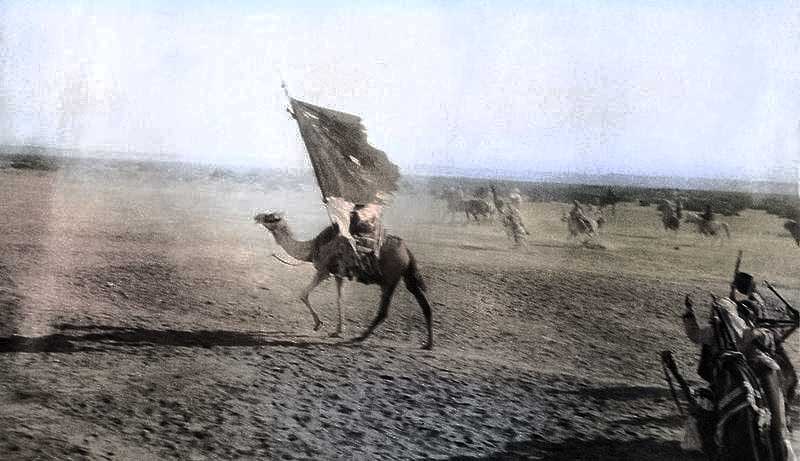
On July 5, there was a short exchange of fire at Khadra, and Lawrence found his force had swelled to over 1,000 men as tribesmen of the Howeitat and Haywat arrived to participate in the final attack. Despite attempts at negotiations to induce surrender, the Turkish commander at Aqaba decided to capitulate after an exchange of fire on July 6. The Arabs' final dash took place without a shot being fired, and Lawrence later summarized the final act in his memoir, Seven Pillars of Wisdom.
Guerrilla War, 1917-1918
The British capture of Aqaba opened up new strategic opportunities, such as a pathway to Palestine and Syria from Wadi Ithm and a stronghold for the Arab Northern Army to counter the Hejaz Railway. In late 1917 and 1918, the Arab Army targeted the Ma'an and Mudawarrah stations as objectives within reach. The Arab Northern Army advanced from Wejh to Aqaba with assistance from the Royal Navy. Lawrence, who was promoted to the rank of major, originally aspired to become the highest-ranking British officer at Aqaba. Lt. Col. Joyce took command, while Lawrence continued as the primary intermediary between Feisal and the senior British officer overseeing the tribal contingents. The Arab Northern Army consisted of a conventional unit and an unconventional group of Arab tribesmen. Jafar Pasha al-Askari led a standard military unit of approximately 2,000 soldiers, primarily consisting of former prisoners of war, structured in a traditional manner. Lawrence was primarily focused on the irregular tribal force, consisting of approximately 6,000 men from tribes like the Howeitat, Bani 'Ali, and Juhaynah. Lawrence and Feisal supervised the overall course of their actions.
The Arab forces in Aqaba received support from Royal Navy gunboats and an RFC flight to defend against Turkish counter-attacks. The RFC offered aerial assistance by conducting reconnaissance, engaging Turkish troops, and carrying out bombing raids. Cairo provided financial support for these endeavors, distributing thousands of pounds of gold coins monthly as payment to the Arab troops. Although the Aqaba raid was successful and there was potential for the Arab Army to assemble there, the revolt became inactive. The Sykes-Picot Agreement disclosed additional information, deteriorating relations with Hashemite leaders. Lawrence tried to lessen the harm by interpreting the agreement in a positive way for Feisal and Sharif Hussein. The Ottoman government's proposal of gold to tribal leaders and Hussein intensified political apprehensions. A potential Turkish retaliation on Aqaba was anticipated, but the Turkish attack lost momentum and faded away after a few months.
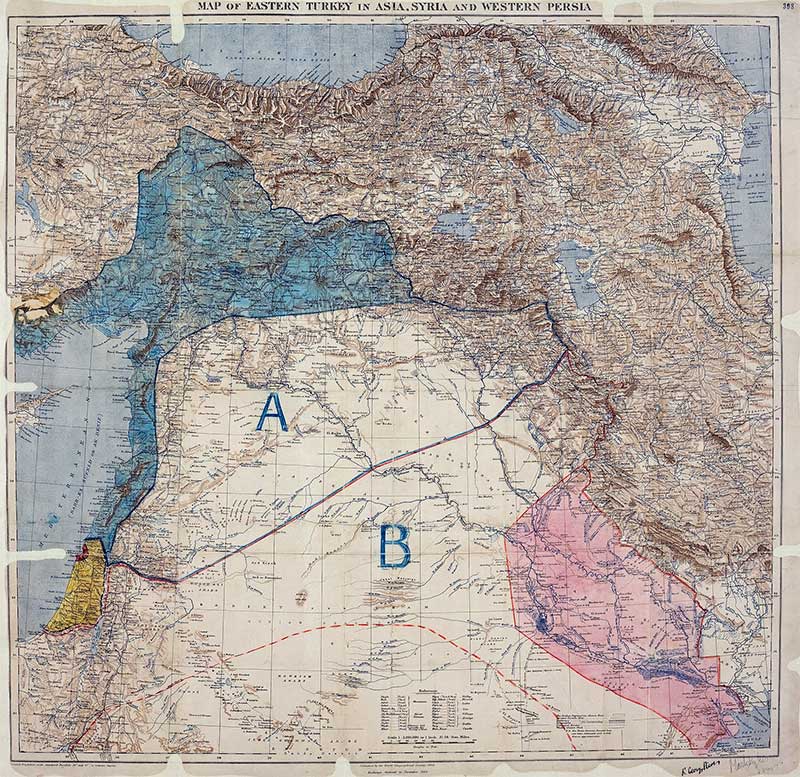
During the initial phases of World War I, the Arab Army maintained its military operations by conducting raids on the Hejaz Railway. The Arab Army's growing confidence in taking on Turkish forces supported the raids' increasing size and boldness. Over 500 charges were detonated on the line south of al 'Ula in July 1917. Lawrence played a crucial role in the development of tactics used in railway raids. He thought that confronting bigger railway garrisons would not pose a significant challenge for his tribal forces. To address this imbalance, he incorporated machine-gun and mortar teams into his raiding parties, eventually expanding to include mountain guns, truck-mounted artillery, and armored cars. Lawrence's attack on Mudawwarah on September 17-18, 1917, showcased the effective utilization of firepower in his military maneuvers. He utilized a Lewis light machine gun and a Stokes mortar to control the Turkish garrison and placed a substantial mine on a nearby bridge, resulting in the destruction of both the bridge and a passing train.
In September and October 1917, Lawrence and Captain Pisani commanded a group of 80 tribesmen in a railway raid, where they destroyed parts of the railway and a crucial bridge. The Arab regular army advanced into the southern Sinai region and achieved victory over a sizable Turkish military unit at Wadi Musa. Lawrence, an advocate of air power, started constructing temporary airfields in the Sinai to assist aircraft flying from Suez across the Sinai. Lawrence consistently carried out attacks on the railway, resulting in substantial damage. In one attack, he destroyed a train but was injured by a Turkish bullet. They detonated explosives on 17 trains and caused significant damage to the railway in the subsequent months. Lawrence traveled to Cairo on October 11 to meet with General Allenby, who was organizing a new military attack along the Gaza-Beersheba line. Lawrence had previously assured that a general rebellion could start in Syria, but later understood it would lead to extensive retaliations against the Syrian population. He suggested demolishing the westernmost bridge in the Yarmuk Valley at Jisr al-Hemmi to halt railway traffic for a minimum of two weeks and sever the primary route of withdrawal for the Turks from Jerusalem to Damascus. Lawrence agreed to detonate the bridge on November 5 or within the following three nights, but his colleagues noticed that he was becoming stressed. Clayton, the head of intelligence, voiced concern about Lawrence's workload and the pressure it was putting on him.
Lawrence tried to recreate his triumph at Aqaba by organizing an extensive raid, heading northeast, and establishing his operations at the partially destroyed Crusader castle in Azrak. Along with an Indian Army machine-gun team under the command of Jamadar Hassan Shah, Lieutenant Wood, and Trooper Throne, he led a small group of tribesmen, including the Bani Shakr and Serahiyyin. Abd al-Qadir, an Algerian expatriate in Syria and descendant of a guerrilla commander, was devoted to his faction. Colonel Brémond, the leader of the French mission, informed Lawrence that al-Qadir was believed to be a Turkish spy. Lawrence departed from Aqaba on October 24 and took an indirect route to Azrak in order to evade Turkish detection. However, the situation took a turn for the worse when Abd al-Qadir and his men vanished during the night of 4–5 November, raising suspicions that he had gone to alert the Turks. Lawrence's initial goal, Jisr al-Hemmi, was situated in an area where the inhabitants were supportive of the Turks, and Arab leaders informed him that it was not feasible to launch a successful attack on it.
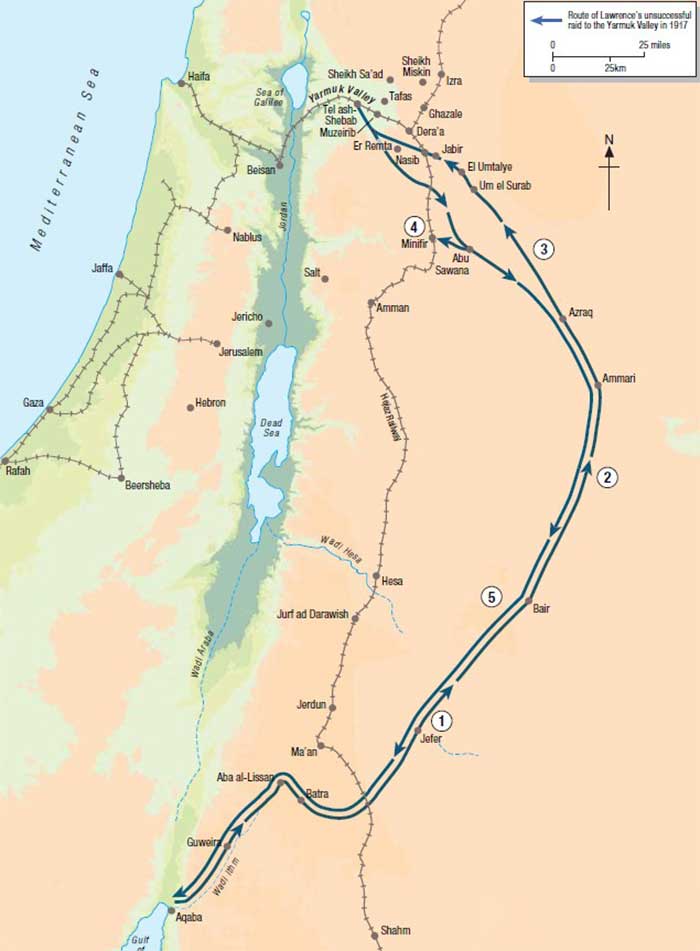
The raid on the Yarmuk Valley bridges took place on November 7-8, 1917. A local farmer shot at Lawrence and his men, resulting in an almost simulated attack. Turkish sentries' noise and fire alerted Lawrence's party, causing them to scatter into the darkness and drop their explosives and equipment. The machine-gun team was unable to shoot, and Lawrence discovered he lacked sufficient explosives to detonate the bridge. As they withdrew under the cover of darkness, they listened to the British artillery firing, indicating their defeat. While retreating to Azrak, Lawrence successfully demolished two culverts and the train of the Ottoman VIII Corps commander. Yet, this provided only minimal comfort for the failed operation at the Yarmuk Valley bridges. Lawrence came back to Azrak on 12 November, but the events between 14 and 22 November are unknown. As described in his book Seven Pillars of Wisdom, he departed to scout Dera'a, an important Turkish stronghold and key point on the Hejaz Railway. While there, Lawrence alleged that he was captured, assaulted, subjected to torture, and subsequently sexually assaulted by the Turkish leader. Later biographers have raised doubts about the accuracy of Lawrence's account, making this episode a subject of controversy in his story. There is significant uncertainty regarding Lawrence's ability to have journeyed from Azrak to Dera'a and then from Azrak to Aqaba within the allotted time. The Dera'a incident is a topic of disagreement among Lawrence biographers and fans, sparking discussions on topics like Lawrence's sexuality and post-war masochistic behaviors.
Upon his return to Aqaba, Lawrence enlisted a bodyguard consisting of 90 men, predominantly Agayl. Initially, the bodyguard had only 12 men, but by the war's end, it had approximately 90 members. Lawrence retained this group of tough and skilled individuals with him for the rest of the war. Upon his return to Aqaba, Lawrence anticipated criticism for the unsuccessful Yarmuk raid, but Allenby was satisfied with his performance. The British attack penetrated the Gaza-Beersheba line, while Lawrence's raid effectively drew away Turkish troops from the battlefield. British forces captured Jerusalem on December 9th, and Lawrence was observed in the background in official film recordings.
Final Campaigns, 1917-1918
In late 1917, the British mission encountered difficulties when the Arab Northern Army received additional military support, including Rolls-Royce armored cars, Talbot cars equipped with 10-pounder guns, Ford light cars, and French mountain guns. The new additions provided substantial mobility and firepower, which British officers evaluated in wadis and rugged terrain in Aqaba. The stage appeared to be ready for a new stage of the Arab Revolt, which would lead Feisal's army into Palestine and Syria.
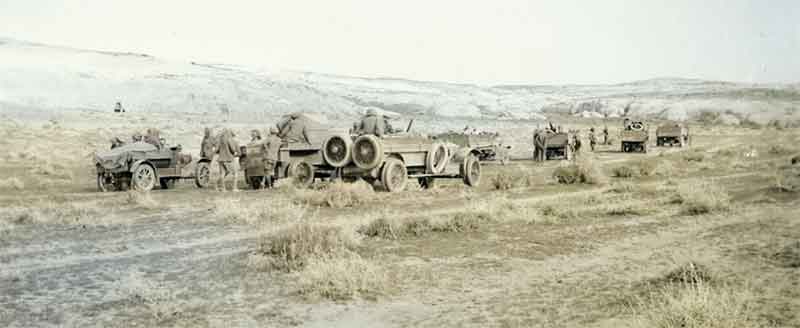
Arab leaders became increasingly dissatisfied when the new Bolshevik government in Russia revealed all the details of the Sykes-Picot Agreement. The Balfour Declaration of November 1917, which pledged a Jewish homeland in Palestine, exacerbated tensions within the Arab Army. Cemal Pasha approached Arab leaders, offering them money and amnesty. A Turkish train was attacked in the north of al 'Ula in November. It was discovered to be transporting more than £24,000 worth of gold, raising suspicions that the gold was meant to be used to bribe Arab leaders. Lawrence attempted to reassure Feisal and establish communication with Sharif Hussein during a series of challenging meetings. The publication of President Woodrow Wilson's letter to the Arabs helped to lessen Arab uncertainties. The 'Fourteen Points' speech on January 8, 1918, pledged to ensure the safety and freedom for the development of other nationalities living under Turkish control. Arab leaders continued to hold on to this guarantee, but Lawrence was aware that the Sykes-Picot agreements would outweigh these assurances. After the war, Lawrence's integrity diminished, and this feeling worsened in the years following the war.
In late 1917, Lawrence and Lt. Col. Joyce conducted experiments with armored cars and Talbot cars, engaging in raids on the Hejaz Railway. They discovered that armored vehicles could be utilized to quell Turkish positions while carrying out demolitions. The Talbot battery initiated the attack on the Hejaz Railway on January 1, 1918, as the armored cars maneuvered around the Turkish earthwork. The enemy soldiers greeted the cars but fired at them sporadically, as if attempting to protect against a rhinoceros with birdshot. This experience had a significant impact on the direction of the war in the Middle East. In 1918, Lawrence and Allenby deliberated on the significance of the Arab Army's role in the campaign, aiming for a decisive outcome. An Arab military unit seized control of Tafila on January 16th, a significant town located in the wheat-producing highlands to the east of the Dead Sea. The British aimed to connect with the Arab Army to create an unbroken line extending from the sea to a position past the Turkish left flank. However, this situation would not occur because of the terrain obstacles and Turkish counter-offensives.
Retaining Tafila became challenging when a Turkish brigade advanced south from Kerek to recapture the town. Lawrence encountered a Turkish army of approximately 1,000 soldiers, including infantry, cavalry, two mountain guns, and more than 20 machine guns and light machine guns. A coordinated series of flanking maneuvers carried out by Arab cavalry determined the outcome of an intense conflict that erupted between Arab and Turkish forces and lasted for more than two hours. Lawrence advanced his group in a direct assault, causing the Turkish army to break apart and run away. The battle of Tafila was a brief and chaotic engagement, demonstrating the Arab irregular troops' readiness to confront Turkish forces in direct combat. It led to the apprehension of more than 250 Turkish soldiers, along with their two mountain artillery pieces. Lawrence received the Distinguished Service Order (DSO) based on his report of the battle, which he later acknowledged was somewhat humorous.
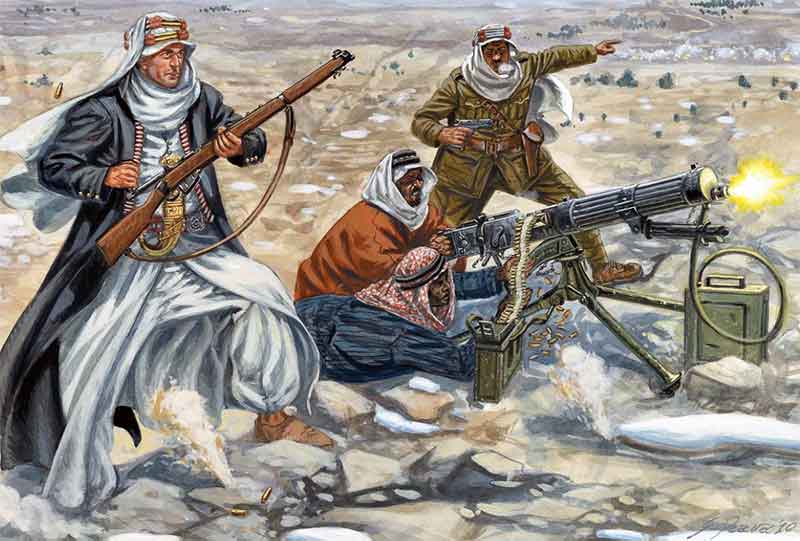
Lawrence experienced frustration in the months after Tafila, as efforts to gather tribal levies for the Arabs were blocked. He found out that the £30,000 he had given to Emir Zeid had vanished, causing disappointment and prompting a report to Cairo that the Arabs were unsuitable material for incorporation into a design. The British failed in their April attempt to capture Ma'an, leading to a prolonged siege by the Arab Regular Army until September 23. The primary British offensive against Amman was unsuccessful, and multiple assaults on the Hejaz Railway did not result in capturing Mudawwarah. The Imperial Camel Corps troops captured the station on August 8, 1918, halting rail traffic heading south to Medina. Lawrence and Allenby both anticipated that applying pressure across the Turkish front would lead to a complete collapse in a matter of months. Allenby intended to penetrate the Turkish defensive line at Megiddo by utilizing the maneuverability of his Desert Mounted Corps on a limited front. The Royal Air Force (RAF) utilized air power to bomb roads, junctions, and assembly areas, as well as to target Turkish troops on the ground. Lawrence organized a small and agile group from the Arab Northern Army, which consisted of Gurkha machine-gun teams, Capitaine Pisani's mountain-gun battery, and a detachment of the Camel Corps.
Lawrence and Allenby reached a consensus on a sequence of assaults designed to create disorder among the Turkish forces and disrupt their unity. Lawrence and his forces launched an attack on the railway on September 16, 1918, raiding both the north and south of Dera'a. The primary offensive commenced on September 19 by severing the railway line and isolating Dera'a. The joint momentum of Allenby's offensive and Lawrence's assaults started to weaken Turkish unity, causing soldiers to retreat on foot. On September 27, approximately 2,000 Turkish soldiers, which included 250 German and Austrian troops, withdrew from Mezerib and traveled through the village of Tafas. Lawrence, commanding his tribesmen, directed an assault on the column, declaring a 'no prisoners' directive. Subsequent events are unclear, but it is confirmed that Arab tribesmen assaulted the column and eliminated the majority of the Turkish soldiers. Lawrence later stated in the Seven Pillars of Wisdom that this action was in retaliation for the massacre at Tafas. Approximately 250 soldiers, consisting of Germans and Austrians, surrendered. Lawrence later admitted to his brother Arnie that he had ordered them to be machine-gunned.
The massacre at Tafas, which killed men, women, and children, and previous experiences with conflict influenced Lawrence's behavior during the Middle East war. As Turkish resistance weakened, comparable events unfolded as British and Arab forces progressed. In October 1918, Ottoman authority in Syria collapsed, prompting Lawrence and his tribal forces to engage in combat to drive the Turks northward. The 4th and 5th Cavalry Divisions were pivotal in the concluding maneuvers. As the Turkish command structure disintegrated, numerous Turkish soldiers surrendered, resulting in Allenby's Megiddo offensive being a complete success. Arab tribesmen, British, and Australian cavalry captured Damascus, Arab troops seized Aleppo, and Arab and British troops took control of the railway junction at Muslimiya, disrupting the Turkish rail connection to Mesopotamia. The Ottoman Empire requested peace and was given an armistice on October 31, thus concluding the war in the Middle East.
Lawrence's military campaign concluded on October 1 when he arrived in Damascus, where his tribesmen persistently troubled the withdrawing Turks. He abandoned them and proceeded into the town, where he experienced physical and emotional fatigue. Damascus was in a state of utter destruction, with services disrupted and widespread chaos. Lawrence visited a Turkish hospital and observed the sick and wounded in a distressing condition. A medical officer referred to Lawrence as a 'bloody brute', a description that Lawrence eventually acknowledged as accurate.
The victors in Damascus were jubilant, while Lawrence experienced contrasting personal emotions. During a tense meeting on October 3, Allenby conveyed to Feisal that he would not ascend to the throne of Syria, as the French would govern the region as per the Sykes-Picot Agreement. This eliminated any enduring misconceptions that Feisal and Lawrence harbored. James McBey created a portrait of Lawrence in one sitting, and Arab leaders said goodbye to him as he departed. Lawrence obtained authorization from Allenby to depart following the meeting with Feisal. He wrote: After Feisal departed, I asked Allenby for permission to leave, which was the first and last request I ever made for myself. Initially resistant, I persuaded him by reminding him of his one-year-old commitment and highlighting the potential benefits of the New Law without my influence on the people. He eventually consented, and immediately I realized the depth of my regret.
Colonel Lawrence, decorated with a Distinguished Service Order (DSO) and Companion of the Order of the Bath (CB), arrived back in Cairo in October 1918. He had previously served in Damascus as a lieutenant in 1916. General Allenby proposed him for knighthood, but the revolt's result was a major letdown for him. Later, he claimed that the powerful force of success had destroyed his dreams.
Inside the Mind of T.E. Lawrence
Lawrence has risen from humble origins to become a prominent figure of the 20th century. He had a significant impact in a military capacity during World War I. He possessed a thorough understanding of guerrilla warfare as a military commander and was able to effectively implement it and articulate it through writing. His theories on irregular warfare are proven accurate by his repeated return to his writings. His instinct, combined with his expertise in the tribes and geography of Arabia, enabled him to operate successfully during World War I. Desert explorers in the 1920s and 1930s would further develop his skill at commanding unconventional forces in the desert while using light armor and artillery. During desert operations in World War II, special forces like the Long Range Desert Group and the SAS used these techniques. Consequently, Lawrence continues to be a highly influential figure in guerrilla warfare and the advancement of desert-warfare strategies.
In Chapter XXXIII of Seven Pillars of Wisdom, the author provides a concise summary of his approach to warfare, detailing a time in early 1917 when he was confined to bed due to illness. During this time, he formulated his concepts on how the campaign should be carried out. The individual evaluated the strengths and weaknesses of the Turkish forces and analyzed the advantages that the Arab forces possessed in comparison to the Turks. Students studying asymmetric warfare still acknowledge many of the principles he included in his final assessment. Lawrence refused to adopt the offensive attitude commonly seen in commanders on the Western Front. He understood that the Turks were obligated to defend land in Arabia, including the Hejaz Railway. They had to sacrifice mobility in exchange for being dependent on vulnerable communication routes. On the contrary, the Arabs were able to cover great distances and engage in surprise attacks during warfare. Obtaining a moderate amount of machine guns and explosives would help them enhance their superiority.
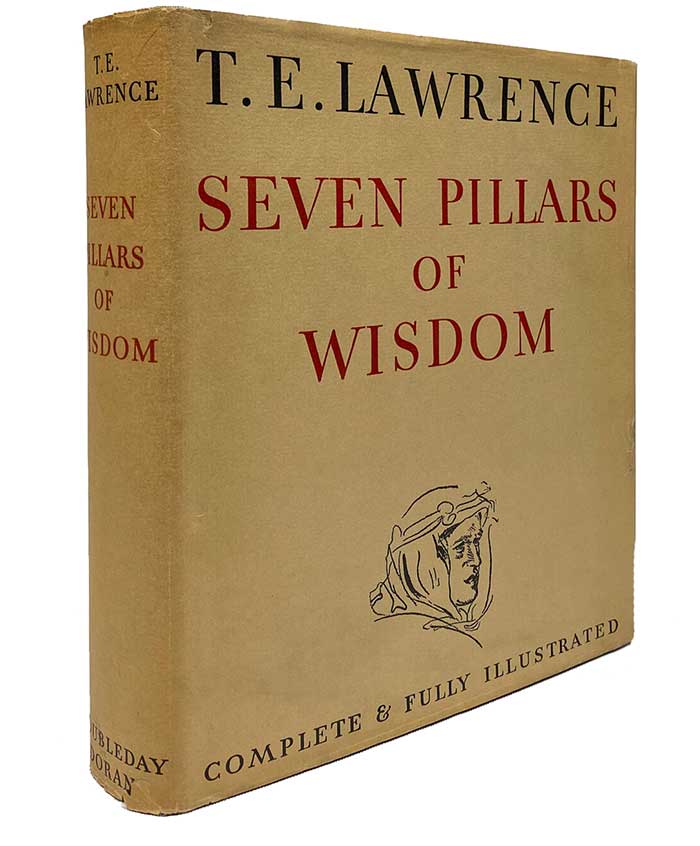
Lawrence neatly summed up his ideas: Many wars were initiated by forces seeking contact to prevent tactical surprise. Our approach should prioritize detachment in this conflict. We planned to encircle the enemy using the intimidating presence of a large, unexplored desert, keeping our presence hidden until we launched our attack. The attack would be minimal, aimed at his possessions rather than him, targeting his most easily reachable belongings without considering his strengths or weaknesses.
Lawrence, a guerrilla leader, recognized the benefits of armored car units and air support when integrated with his tribal troops. By doing this, a small group was able to deploy substantial firepower against the enemy, which proved highly effective in subsequent phases of the conflict. As a desert commander, Lawrence devised strategies to navigate and endure the challenging terrain, including the strategic use of wells and the upkeep of motor vehicles. He used this strategy to travel long distances and gain a tactical edge in order to attack his target, which was the foundation of the Aqaba raid. Lawrence was reluctant to endure avoidable losses, understanding that casualties among his Arab troops would have significant consequences in Arab society. Debates continue regarding his stance on bloodshed, as some incidents indicate that the war had toughened him, and he acknowledged the need for violence. In private correspondence, Lawrence expressed his candid feelings, acknowledging the dreadful nature of killing Turks. He admitted to having committed numerous killings in the past and anticipated having to do many more in the future.
Lawrence, a wartime leader, encountered conflict with his fellow officers because of his limited pre-war military background. He suggested utilizing the Imperial Camel Corps and executed a significant raid plan without authorization from Cairo. Lawrence's extensive intelligence enabled him to create his own strategy of desert guerrilla warfare, even though he struggled with working as part of a team. Recent conflicts in Iraq and Afghanistan have prompted a reexamination of Lawrence's writings and experiences. However, it is important to exercise caution, as Lawrence's experiences are unique to the time and circumstances in which he lived. Lawrence viewed the war from the perspective of the insurgents, and contemporary advocates of counter-insurgency should take this into account when analyzing his work. Lawrence remains a valuable resource for contemporary readers due to his advocacy of asymmetric warfare. His account also validates the notion that during World War I, a single officer had the ability to impact and shape the result of a whole military operation.
After the War
Lord Allenby characterized Lawrence as a reserved and scholarly individual with expertise in archaeology and philosophy, unexpectedly thrust into a significant role during the war. Although accused of excessive ambition, he found the post-war public scrutiny overwhelming. His retreat from society and refusal to pursue career opportunities across different fields could be interpreted as evidence that he found the pressure of the 'Lawrence Myth' overwhelming. Lawrence was skeptical about the likelihood of a fair post-war agreement in the Middle East but stayed dedicated to the Arab cause. He declined a knighthood in objection to how the Arabs were being treated. In 1919, he went with Prince Feisal to the Paris Peace Conference as a member of the Arab delegation. The Sykes-Picot Agreement during wartime rendered Arab representations ineffective, resulting in the division of former Ottoman territories in the Middle East between Britain and France.
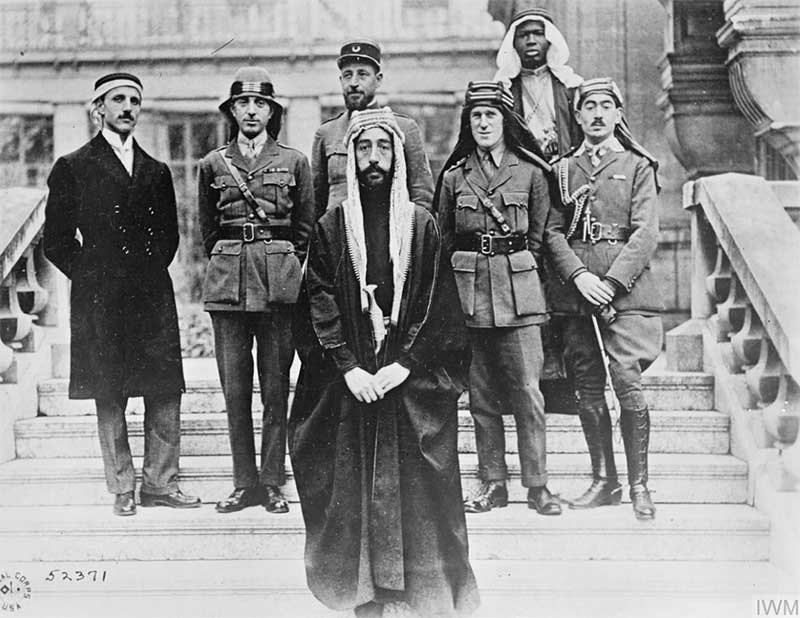
In 1919, Lawrence initiated the writing of his memoir, Seven Pillars of Wisdom, and was named a research fellow at All Souls College in Oxford. His renown extended beyond Britain, and his broader public recognition began in August 1919 with Lowell Thomas's show at Covent Garden titled With Allenby in Palestine. Thomas had amassed film footage and still photographs of Lawrence during the war, captivating his audience with his tale. He convened meetings with Lawrence and participated in additional photo sessions. Thomas' latest production, With Allenby in Palestine and Lawrence in Arabia, attracted large audiences in London and embarked on a tour across Britain. By 1920, Lawrence had achieved legendary status, despite experiencing dehumanizing warfare and facing anonymous death on the Western Front. The charismatic individual captivated and attracted the general public.
Lawrence has faced criticism for his actions in response to public and press attention, but he also attempted to leverage his fame to support the Arab cause and advocate for the fulfillment of wartime commitments to Arab leaders. In 1920, Iraq experienced a rebellion following the British administration of the country as part of their mandate. Lawrence became more outspoken regarding British policy in that area. On August 2, 1920, he expressed in The Times that the people of England had been ensnared in Mesopotamia, making it difficult to extricate themselves with dignity and honor. They were deceived through a consistent lack of information. The Baghdad communiqués are delayed, insincere, and lacking in detail. Our situation is more dire, and our administration is more brutal and ineffective than what has been disclosed to the public. It is a stain on our imperial history and might soon get too bad for conventional methods to fix. Today, we are close to a disaster.
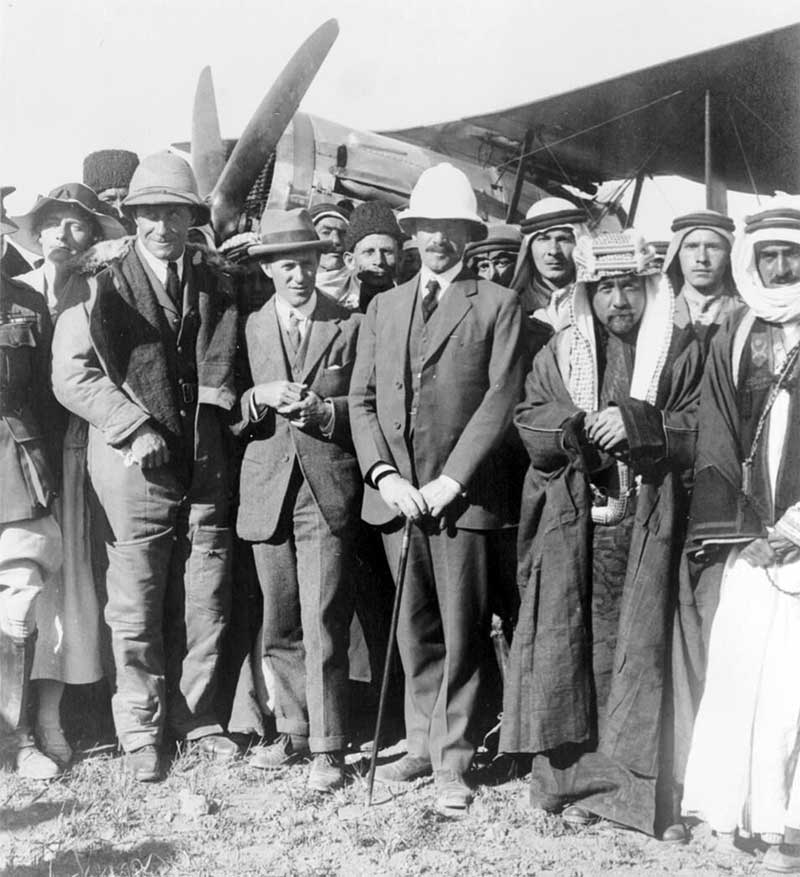
Lawrence, a notable British military figure, criticized French military operations in Syria and was asked to serve as an advisor on Arab affairs at the Colonial Office. In 1921, he joined Winston Churchill at the Cairo Conference as one of the 40 experts tasked with reaching an agreement on the administration of mandated territories. The conference led to the successful finalization of an Anglo-Iraqi treaty and the appointment of Feisal as the king of Iraq. This form of government persisted in Iraq until the Ba'athist revolution of 1958, despite facing threats. Upon his return to England, Lawrence recognized that he would never achieve success in compelling a fair resolution in Arabia, despite his public image and media manipulation. In 1922, he relinquished all positions and enlisted in the RAF. In 1923, he joined the Tank Corps and adopted the name T. E. Shaw. Lawrence reenlisted in the RAF in 1925 and served until he retired in 1935.
In 1922, T.E. Lawrence declined different career opportunities and pursued anonymity in the RAF, sparking discussions about his reasons. Some speculate that the action was a publicity stunt, a form of protest against Arab treatment, a result of wartime stress, disillusionment with British politics, or struggles with his own sexuality and identity. However, Lawrence's correspondence with intimate acquaintances reveals his struggle to adapt to life as an enlisted soldier among comrades he considered coarse. Although he lived discreetly at different RAF stations, he still garnered media attention, leading to speculation about his involvement in espionage activities targeting Afghanistan. Lawrence persisted in working on literary endeavors such as the Seven Pillars of Wisdom and a translation of Homer's Odyssey. He initiated writing a memoir about his time in the RAF called The Mint, which was later published under the same title. Additionally, he made contributions to the Encyclopedia Britannica. Debates have arisen regarding his decision to reject a career, public life, and identity.
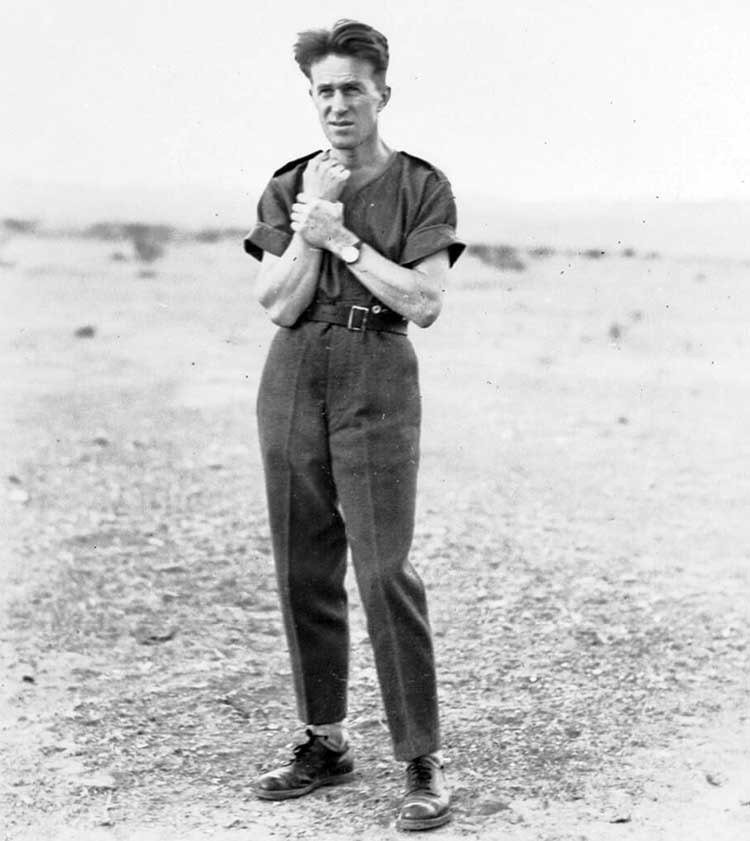
Lawrence, an enthusiastic RAF pilot, possessed a collection of Brough motorcycles in the 1920s and 1930s, which he later referred to as 'voluntary danger'. He also took pleasure in flying and went on many aerial journeys during and after the war. Despite lacking the skill to fly, he contributed to the advancement of high-speed RAF rescue boats. Lawrence consistently communicated with friends and acquaintances during his professional life. In 1935, he retired from the Royal Air Force (RAF) and resided at Clouds Hill in Dorset.
He suffered severe head injuries in a motorcycle accident on May 13th. He passed away on May 19, 1935, six days after the incident. A significant number of people, including military personnel and notable figures such as Winston Churchill, Siegfried Sassoon, General A.P. Wavell, Colonel Newcombe, Sir Ronald Storrs, and Lady Astor, attended his funeral. Arnold Lawrence, the brother, led the mourners, and King George V received a telegram acknowledging his exceptional services to the country.
Thomas Edward Lawrence (Lawrence of Arabia) - Quick Facts
- Arabia 1916-1918
- United Kingdom
- British Army
- Royal Air Force
- {{#owner}}
- {{#url}} {{#avatarSrc}}
{{name}} {{/url}} {{^url}} {{#avatar}} {{& avatar}} {{/avatar}} {{name}} {{/url}} - {{/owner}} {{#created}}
- {{created}} {{/created}}


